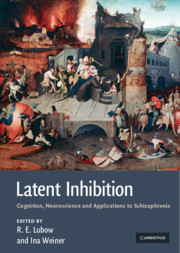Book contents
- Frontmatter
- Contents
- List of contributors
- Preface
- 1 A short history of latent inhibition research
- Current topics in latent inhibition research
- 2 Latent inhibition and extinction: their signature phenomena and the role of prediction error
- 3 Inter-stage context and time as determinants of latent inhibition
- 4 Latent inhibition: acquisition or performance deficit?
- 5 Latent inhibition and learned irrelevance in human contingency learning
- 6 Associative and nonassociative processes in latent inhibition: an elaboration of the Pearce–Hall model
- 7 From latent inhibition to retrospective revaluation: an attentional-associative model
- 8 Latent inhibition and habituation: evaluation of an associative analysis
- 9 Latent inhibition and creativity
- 10 The phylogenetic distribution of latent inhibition
- 11 The genetics of latent inhibition: studies of inbred and mutant mice
- 12 A comparison of mechanisms underlying the CS–US association and the CS–nothing association
- 13 The pharmacology of latent inhibition and its relevance to schizophrenia
- 14 Parahippocampal region–dopaminergic neuron relationships in latent inhibition
- 15 Latent inhibition and other salience modulation effects: same neural substrates?
- 16 What the brain teaches us about latent inhibition (LI): the neural substrates of the expression and prevention of LI
- 17 Latent inhibition in schizophrenia and schizotypy: a review of the empirical literature
- 18 A cautionary note about latent inhibition in schizophrenia: are we ignoring relevant information?
- 19 Latent inhibition as a function of anxiety and stress: implications for schizophrenia
- 20 Nicotinic modulation of attentional deficits in schizophrenia
- 21 Latent inhibition and schizophrenia: the ins and outs of context
- Summary and conclusions
- Index
- References
19 - Latent inhibition as a function of anxiety and stress: implications for schizophrenia
from Current topics in latent inhibition research
Published online by Cambridge University Press: 04 August 2010
- Frontmatter
- Contents
- List of contributors
- Preface
- 1 A short history of latent inhibition research
- Current topics in latent inhibition research
- 2 Latent inhibition and extinction: their signature phenomena and the role of prediction error
- 3 Inter-stage context and time as determinants of latent inhibition
- 4 Latent inhibition: acquisition or performance deficit?
- 5 Latent inhibition and learned irrelevance in human contingency learning
- 6 Associative and nonassociative processes in latent inhibition: an elaboration of the Pearce–Hall model
- 7 From latent inhibition to retrospective revaluation: an attentional-associative model
- 8 Latent inhibition and habituation: evaluation of an associative analysis
- 9 Latent inhibition and creativity
- 10 The phylogenetic distribution of latent inhibition
- 11 The genetics of latent inhibition: studies of inbred and mutant mice
- 12 A comparison of mechanisms underlying the CS–US association and the CS–nothing association
- 13 The pharmacology of latent inhibition and its relevance to schizophrenia
- 14 Parahippocampal region–dopaminergic neuron relationships in latent inhibition
- 15 Latent inhibition and other salience modulation effects: same neural substrates?
- 16 What the brain teaches us about latent inhibition (LI): the neural substrates of the expression and prevention of LI
- 17 Latent inhibition in schizophrenia and schizotypy: a review of the empirical literature
- 18 A cautionary note about latent inhibition in schizophrenia: are we ignoring relevant information?
- 19 Latent inhibition as a function of anxiety and stress: implications for schizophrenia
- 20 Nicotinic modulation of attentional deficits in schizophrenia
- 21 Latent inhibition and schizophrenia: the ins and outs of context
- Summary and conclusions
- Index
- References
Summary
Selective attention is a process which requires that an individual devotes attention to a task-relevant stimulus and processes it, while ignoring a distracting-irrelevant stimulus. The ability to selectively attend and respond effectively to relevant stimuli is essential for adaptive behavior and normal cognitive functioning, since, according to capacity approaches (e.g., Kahneman, 1973; Navon & Gopher, 1979), attention exists in limited amounts and might be allocated to irrelevant as well as relevant information (e.g., Gopher, 1992).
That normal selective attention is essential for adaptive behavior is supported by the literature which shows a relationship between psychopathology and the impairment of selective attentional processes. The most prominent example of such a relationship is the attentional deficit of schizophrenics and “normal” schizotypals. Studies have shown that, as compared to normal individuals, schizophrenics and schizotypals are distracted by irrelevant stimuli (see below). In addition, there is evidence that individuals characterized by high levels of anxiety also are distracted by irrelevant stimuli, although most studies suggest that anxiety leads to an attentional bias only for irrelevant threat-related stimuli.
Surprisingly, despite the similarity of selective attention impairments in schizophrenia/schizotypy and anxiety, there are hardly any studies that have tested whether the anxiety that characterizes schizophrenia/schizotypy accounts for (even only partially) the difficulties schizophrenics/schizotypals have in ignoring irrelevant information.
This chapter will present data about selective attentional dysfunction in groups rated low and high on self-report anxiety and schizotypy scales and in situations that elicit anxiety (stress).
- Type
- Chapter
- Information
- Latent InhibitionCognition, Neuroscience and Applications to Schizophrenia, pp. 457 - 476Publisher: Cambridge University PressPrint publication year: 2010



